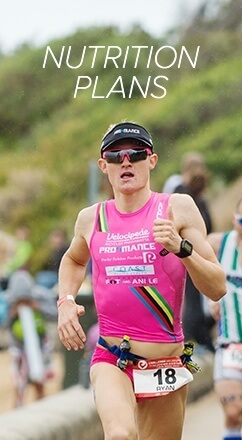What are the benefits of carbohydrates and protein for recovery nutrition?
Studies (Van Hall, 2000 & Van Loon, 2000) have shown that the combined ingestion of glucose and protein increases glycogen re-synthesis and plasma insulin levels in the post-exercise period. Calculations based on glycogen resynthesis rates measured show that it takes 16-20 hours before the glycogen stores are fully replenished after exercise and that co-ingestion of carbohydrates and protein accelerate glycogen re-synthesis by 4-8 hours (Wagenmakers, 1998). Carbohydrate-protein supplements are more effective in the replenishment of muscle glycogen post exercise compared with a carbohydrate supplements of equal carbohydrate content or caloric equivalency when supplementing immediately and 2-hours post exercise (Ivy et al., 2002).
The addition of protein to a carbohydrate supplement also has the added advantage of limiting post exercise muscle damage and promoting muscle protein accretion. Along with a rapid increase in muscle glycogen, these processes can have a significant impact on subsequent exercise performance (Ivy, 2004).
Why does Procover contain simple and complex carbohydrates?
Carbohydrate ingestion post exercise increases liver and muscle glycogen resynthesis and exercise capacity. It has been shown that simple carbohydrates (dextrose) resulted in quicker muscle glycogen repletion compared to complex carbohydrates. However, over a 4-hour recovery period, complex carbohydrates resulted in greater liver glycogen repletion (Freidman et al., 1991). Combinations of simplex and complex carbohydrates ensure optimal glycogen resynthesis post exercise.
What is the recommended amount of carbohydrate/protein to maximise recovery post exercise?
For muscle glycogen recovery, it is recommended that athletes consume 50-100g of rapidly absorbed carbohydrates and 10-20g of protein within 15 minutes of stopping exercise. It is advised that athletes continue to consume 50-100g of carbohydrates plus 10-20g of protein every hour until their next complete meal (AIS Sports Nutrition, 2009). To be more specific for individual athletes, current evidence suggests that to maximize glycogen resynthesis, athletes should consume 0.8g·kg−1·h−1 carbohydrates combined with 0.3g·kg−1·h−1 amino acids or protein immediately after exercise and every hour after exercise during a 4-hour recovery period (Spaccarotella et al., 2011 & Ivy., 2004).
What is the optimal timing of carbohydrate consumption post exercise?
It has been found that muscle glycogen synthesis is more rapid if carbohydrates are consumed immediately following exercise as opposed to waiting several hours (Ivy et al., 1988a). When carbohydrates are consumed immediately after exercise the rate of glycogen synthesis averages between 6 to 8 mmol·kg-1 wet wt·h-1; whereas, if the supplement is delayed several hours the rate of synthesis is reduced 50% (Blom et al., 1987; Ivy et al., 1988a). The increased synthesis immediately post exercise is due, in part, to a faster rate of muscle glucose uptake as a result of an increase in muscle insulin sensitivity (Cartee et al., 1989), and an increase in the concentration of glucose transporters associated with the plasma membrane of the muscle (Etgen et al., 1996). With time, however, the increase in insulin sensitivity and membrane glucose transporter concentration declines resulting in a slower rate of muscle glucose uptake and glycogen storage.
Why does Procover contain whey and casein protein?
Combining whey and casein proteins lead to a greater anabolic environment compared to a single protein source (Wilkinson et al., 2007). Whey protein is referred to as a ‘‘fast’’ protein because it is rapidly digested and leads to a large, albeit temporary rise in plasma amino acid levels (Boirie et al. 1997). Whey protein’s amino acid profile is almost identical to that of skeletal muscle, providing all the amino acids in approximate proportion to their ratios in skeletal muscle (Rennie & Tipton, 2000). Casein is referred to as a “slow” protein since the modest increase in plasma amino acid concentrations is more gradual and prolonged (Boirie et al., 1997). Using amino acid tracer methodology, it was demonstrated that whey protein elicits a sharp, rapid increase of plasma amino acids following ingestion, while the consumption of casein induces a moderate, prolonged increase in plasma amino acids that was sustained over a 7 hour postprandial time period. Casein ingestion does not increase protein synthesis, but reduces protein breakdown (Boirie et al., 1997).
Why does Procover contain sodium?
The addition of sodium to post-exercise recovery drinks stimulates glucose absorption in the small intestine. The active co-transport of glucose and sodium also creates an osmotic gradient that acts to promote net water absorption. Sodium will stimulate thirst, thus allowing the athlete to consume greater quantities of fluid. (Nose et al., 1988a). Studies into sodium (Costill & Sparks, 1973; Nielsen et al., 1986) established that a high urine flow that followed ingestion of large volumes of sodium-free drinks did not allow subjects to remain in positive fluid balance for more than a very short time. They also established that the plasma volume was better maintained when sodium was present. The addition of sodium within a post-exercise recovery drink aids in fluid retention post exercise. Sodium will allow a state of hyperhydration up to 6 hours after fluid is ingested, when an athlete has consumed either 125% or 150% of their sweat loss. The excess fluid will eventually be lost by urine production or by further sweat loss if the individual resumes exercise or moves to a warm environment (Shirreffs, 1996). The ideal recovery beverage should contain 0.3–0.7 g sodium per litre of fluid to help restore sodium lost through sweat (Spaccarotella & Andzel, 2011).
Why does Procover contain potassium?
The addition of potassium to post-exercise recovery drinks replenish potassium stores, which have been depleted during exercise. Potassium is present in intracellular fluid and is responsible for regulating total cell water and stabilizing controlled/automatic muscle contractions. It is lost through sweat and urine at a rate of 5 mmol/L (range 3–15 mmol/L) (Sawka & Montain, 2000; Criswell et al., 1992). During exercise, cells lose potassium during muscle contractions, which eventually increase serum levels instigating fatigue. Potassium intake increases markers of recovery, via muscle cell hydration and prevents intracellular dehydration (Tarnopolsky et al., 1996). Potassium aids the transport of glucose into the muscle cell and assists in the conduction of nerve impulses.
How does Procover limit muscle catabolism and initiate muscle protein accretion?
Although the muscle can have residual catabolic activity following exercise, it is primed to shift into an anabolic state in the presence of the right nutrients. This is due, in part, to an increased sensitivity to insulin. Insulin is one of the most anabolic hormones in the body. Insulin increases muscle amino acid uptake and protein synthesis and reduces protein degradation. Following exercise, raising the plasma insulin level is the key to limiting protracted muscle damage and stimulating protein accretion. Exercise alone does not result in a significant increase in protein synthesis. Procover contains carbohydrates, which can significantly elevate the plasma insulin level and increased protein synthesis by 36% (Roy et al., 1997).
What are the benefits of branched chain amino acids (BCAA) on exercise recovery?
BCAA consist of 3 essential amino acids – leucine, isoleucine and valine. Supplementation of BCAA will increase protein synthesis (Tipton et al., 1999). Activation of protein synthesis by amino acids is most responsive immediately following exercise. Raising the plasma amino acid levels post exercise by infusion or oral supplementation, has been reported to transition the muscle from a negative protein balance to a positive protein balance by stimulating protein synthesis (Rasmussen et al., 2000). When blood amino acid levels are reduced below normal, amino acids are released from the muscle and protein synthesis declines. Elevating the amino acid levels above normal, however, increases amino acid uptake and muscle protein synthesis (Wolfe, 2001). BCAA are found within whey protein isolate and casein protein which are included in Procover.
What are the performance benefits of consuming a post exercise recovery sports drink?
Research suggests that providing a carbohydrate/protein supplement at the appropriate times after exercise will have a significant impact on subsequent exercise performance. It has been found muscle glycogen restoration is 128% greater and exercise performance 55% greater when consuming a carbohydrate/protein recovery drink as compared to the traditional sports drink (Williams et al., 2003).
Plasma creatine phosphokinase (CPK) levels, an indication of muscle tissue damage, were 83% lower prior to the start of subsequent exercise in subjects consuming a carbohydrate/protein drink. It can be concluded that the addition of protein to a carbohydrate supplement produces improvements in aerobic endurance and limits exercise muscle damage (Niles et al., 2001).
What are the benefits of glutamine in recovery nutrition?
Glutamine is a non-essential amino acid which plays a number of important physiological roles. Glutamine promotes muscle anabolism and glycogen synthesis in the recovery period after exercise (Rennie et al., 1996). A decrease in plasma glutamine concentrations, brought about by heavy exercise and training, limits the availability of glutamine for cells of the immune system that require glutamine for energy and nucleotide biosynthesis. Thus, glutamine reduces exercise-induced immune impairment and susceptibility to infection (Gleeson, 2006).
Glutamine is the most important amino acid for kidney ammonia and bicarbonate production, and thus is important for maintaining acid-base balance (Furst & Stehle, 1995). Glutamine increases plasma bicarbonate concentrations and enhances renal acid secretion (Welbourne et al., 1998). Elevated plasma bicarbonate levels can improve exercise performance by buffering against blood acidosis from lactic acid production during supramaximal exercise (Costill et al., 1984).
Does Procover contain arginine and what are the benefits of arginine?
Procover contains glutamine which is converted into citrulline within the small intestine (DiPasquale & Mauro, 1997). In the kidney, citrulline can be converted to arginine. In fact, 64% of arginine derived from de novo synthesis comes from citrulline generated via glutamine (Ligthart-Melis et al., 2008). The anabolic response associated with arginine may be an indirect effect exerted through stimulation of nitric oxide(NO) synthesis and a resulting increase in muscle blood flow (Paddon-Jones et al., 2004). An increase in muscle blood flow supplies a higher proportion of amino acids to the muscle. Arginine boosts the immune system to enhance recovery after exercise and improve training by reducing the risk of overtraining (Barbul, 1998).
Why does Procover contain calcium?
Calcium it a vital mineral within the body. About 99% of the calcium in the body is stored in the skeletal system, while the remaining 1% is present in other cells, such as muscle cells. Although this muscle cell calcium is involved in a variety of physiologic processes associated with energy metabolism and muscle contraction, calcium supplementation is not considered to possess ergogenic potential because, if necessary, the muscle cells may draw on the vast reserves stored in the bone tissue (Williams, 2005). For this reason calcium is not formulated in Proform or Produrance. However, exercise may increase calcium losses within the body, so to ensure replacement of calcium, Procover has been formulated with calcium to restore pre exercise levels.
What are the benefits of Vitamin C?
Vitamins C (Ascorbic acid) is a endogenous powerful antioxidant molecule that act together with other endogenous antioxidant systems within tissue cells in order to scavenge the formed reactive oxygen species (ROS) (Evans et al., 2000). This helps to restore overwhelmed anti-oxidant defences exhibited by athletes and reduce the risk of numerous chronic diseases and enhances immune function (Lowery et al., 2001; Gleeson & Bishop, 2000).
What is the recommended rehydration amount post exercise?
The Australian Institute of Sports recommends that athletes should aim to consume 125-150% of their estimated fluid losses in the 4-6 hours post exercise. The recommendation to consume a volume of fluid greater than that lost in sweat takes into account the continued loss of fluid from the body through sweating and obligatory urine losses (AIS Sports Nutrition, 2009).
How to calculate water loss during exercise using body weight to ensure optimal rehydration
Acute changes in body weight during exercise can be used to calculate sweating rates that occur in different environments (Cheuvront et al., 2002). This approach assumes that 1mL of sweat loss represents a 1g loss in body weight. The before exercise body weight measures are used with the post exercise body weight measurements (Cheuvront et al., 2002). Athletes should weigh themselves prior to training/competing in minimal clothing. Immediately post training/competing, they should weigh themselves again in identical dry clothing on the same set of scales. The differences between pre and post exercise body weight should be consumed at 125-150% to ensure optimal hydration (AIS Sports Nutrition, 2009)
Example:
Pre-exercise weight – 70 kg
Post-exercise weight – 68.5 kg
Fluid deficit (L) = 70 kg – 68.5 kg = 1.5 kg
Total sweat loss (L) = 1.5 kg = 1.5L sweat loss
Water consumption need to rehydrate (L) = 1.875L (125%) or 2.25L (150%)
It is important a athlete rehydrates with a post exercise recovery drink that containing electrolyte to ensure fluid retention post exercise. Electrolytes within a post-exercise recovery drink allows a state of hyperhydration up to 6 hours after fluid is ingested when an athlete has consumed either 125% or 150% of their sweat loss (Nielsen et al., 1986).
To calculate average water loss per hour, athletes should compare the differences between pre and post exercise body weight measurements corrected for urine losses and drink volume (Cheuvront et al., 2002). This will help an athlete ensure they rehydrate correctly during exercise periods in which they cannot measure the body weight measurement changes.
Example:
Pre-exercise weight – 70 kg
Post-exercise weight – 68.5 kg
Volume of fluid consumed during exercise (2 L) – 2 kg & estimated urine losses – 500ml – 500g
Exercise duration – 2 hrs
Fluid deficit (L) = 70kg – 68.5kg = 1.5 kg
Total sweat loss (L) = 1.5 kg + 2 kg – 500g = 3kg (3L sweat loss)
Sweat rate (L/h) = 3 kg/2 h = 1.5 L/h
Therefore the athlete should drink 1.5L of fluid per hour that they have exercised.



